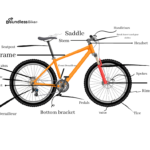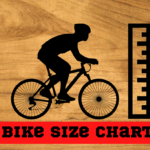Riding a bike is one of the most enjoyable and liberating activities you can do. Whether it’s for commuting, fitness or just pure fun, cycling has become an essential part of many people’s lives. But with so many different types of bikes and sizes available, choosing the right one can be daunting. One question that comes up frequently is whether bike frame size matters? In this blog post, we’ll dive into what bike frame size is, how it affects your riding experience and help you determine if it really does matter when selecting your perfect ride!
What is bike frame size?

Bike frame size is the measurement of the length and height of a bicycle’s main structural frame. It is measured from the center of the bottom bracket to the top tube or seat post, depending on the type of bike. The size affects how comfortable and efficient you are when riding.
A proper frame size ensures that your body is in an optimal position for pedaling efficiency and maneuverability while maintaining comfort. Riding a bike with an ill-fitting frame can cause discomfort, fatigue, pain, and even injury over time.
Factors such as your height, inseam length, arm span, flexibility level and riding style all play into determining what bike frame size is right for you. For instance, road bikes require a different sizing method than mountain bikes due to their unique geometry.
It’s important to note that there isn’t one-size-fits-all when it comes to choosing a bike frame size – every person has different proportions which will affect what works best for them. Therefore, it’s essential to measure yourself correctly or seek expert advice before making any purchases!
How does bike frame size affect riding?
The size of a bike frame can greatly affect your riding experience. A properly fitted bike will not only be more comfortable, but it will also allow you to ride faster and more efficiently.
One way that bike frame size affects riding is through the rider’s position on the bike. If the frame is too small or too large for the rider, they may have to adjust their body position in order to reach the pedals and handlebars comfortably. This can lead to discomfort, pain or even injury over time.
Another factor affected by frame size is stability. A larger frame generally provides more stability at high speeds while a smaller one tends to be more agile and responsive in tight turns.
A correctly sized bike frame also helps with power transfer from pedal stroke to forward motion. When a rider has an optimal fit on their bicycle, they are able to generate maximum power output with each stroke without wasting energy compensating for poor positioning.
Choosing the right bike frame size is essential for an enjoyable and efficient cycling experience whether you’re commuting around town or racing competitively.
Do bike frame size matter?
When it comes to choosing the right bike frame size, there is no one-size-fits-all answer. The ideal bike frame size can vary depending on a number of factors including height, weight, riding style and intended use.
For example, if you are a taller rider with long legs, you may require a larger frame to ensure proper leg extension while pedaling. On the other hand, shorter riders may prefer smaller frames that offer more maneuverability and control.
Additionally, riders who plan on using their bikes for racing or competitive cycling may prefer lighter and more responsive frames that allow for faster speeds and quicker handling. While those who plan on using their bikes for leisurely rides or commuting may prioritize comfort over speed and opt for larger frames with greater stability.
Ultimately, the best way to determine the right bike frame size is to test ride different sizes and styles until you find the perfect fit that feels comfortable yet still meets your specific riding needs.
Bike size Chart
Determining the right bike frame size is crucial for a comfortable and efficient ride. Here’s a general bike frame size chart that you can use as a starting point:
| Rider Height (feet) | Rider Height (cm) | Frame Size (inches) | Frame Size (cm) |
|---|---|---|---|
| 4’10” – 5’1″ | 147 – 155 cm | 13 – 14 | 33 – 36 cm |
| 5’1″ – 5’5″ | 155 – 165 cm | 14 – 15 | 36 – 38 cm |
| 5’5″ – 5’9″ | 165 – 175 cm | 15 – 16 | 38 – 41 cm |
| 5’9″ – 6’0″ | 175 – 183 cm | 16 – 17 | 41 – 43 cm |
| 6’0″ – 6’3″ | 183 – 191 cm | 17 – 18 | 43 – 46 cm |
| 6’3″ – 6’6″ | 191 – 198 cm | 18 – 19 | 46 – 48 cm |
How to choose the right bike frame size?
Choosing the right bike frame size is crucial for a comfortable and efficient ride. A bike that is too small or too large can result in discomfort, pain, and injury. So how do you pick the perfect fit?
Firstly, consider your height and inseam measurements. Most manufacturers provide a sizing chart based on these two factors. However, these charts are not always accurate as they don’t take into account individual body proportions.
Secondly, test ride different sizes of bikes to get an idea of what feels most comfortable to you. Pay attention to the distance between the handlebars and seat as well as the reach from seat to pedals.
Consult with a professional at your local bike shop who can measure your body proportions accurately and recommend ideal frame sizes for different styles of riding.
Remember that finding the right frame size is only one aspect of getting properly fitted on a bike. Handlebar width, stem length, saddle height and position are also important factors that contribute to overall comfort while riding.
Conclusion
Bike frame size does matter when it comes to riding comfort and performance. A poorly fitting bike can result in discomfort, pain, and even injury. Choosing the right frame size is important for all types of riders whether you are a beginner or an experienced cyclist.
To choose the right frame size, consider your height, inseam measurement, riding style, and purpose of use. Take the time to try out different bikes before making a purchase and don’t be afraid to ask for help from a professional.
Remember that having the correct bike frame size can make all the difference between enjoying your ride or suffering through it. So take care in choosing your next bicycle and enjoy many happy rides ahead!
Also read Do bike frames wear out? Quick Answer






